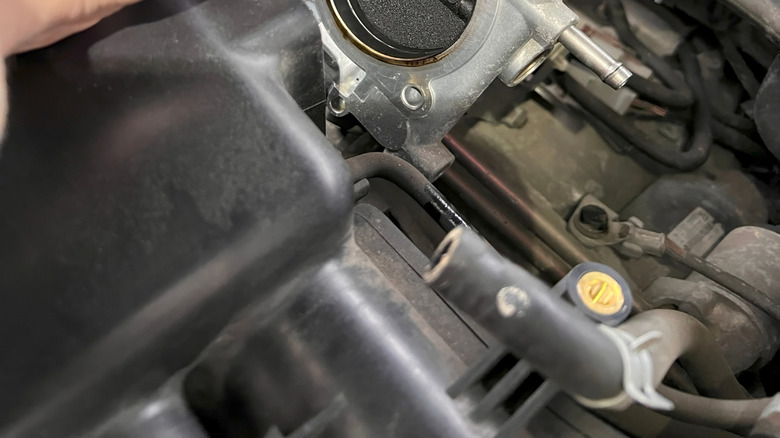What is an oil catch can anyway? Oil catch cans keep direct-injection engines from choking on their own blow-by — here’s the quick-and-dirty on why you may need one. Think of an oil catch can as a tiny quarantine ward spliced into your engine’s positive crankcase ventilation (PCV) hose. Every time a piston fires, a wisp of combustion sneaks past the rings, dragging vaporized fuel and microscopic oil droplets back toward the intake. Left unchecked, the oily fog cakes intercoolers, gums up intake valves, and turns pristine runners into crime-scene walls.
A catch can interrupts the trip and aids in the prevention of carbon buildup. Inside its shell are baffles and screens that force the blow-by to cool, condense, and drop out as liquid sludge. The cleaned-up air continues on to the intake, while the goop stays in the can until you empty it during your next oil change. In short, it’s a spittoon that keeps modern direct-injection engines from choking on their own backwash. Direct-injection engines are already fighting an uphill carbon war, as Jalopnik’s deep dive into Audi’s TFSI tech explains — fuel never washes those valves clean, so whatever doesn’t end up in the catch can ends up as baked-on crud.
How blow-by damages your intake
Blow-by effectively turns your intake into a smokers’ lounge. Four-stroke engine can leak a whisper of combustion past the rings. That rogue pressure drags aerosolized oil and fuel through the PCV hose and straight toward the intake, where emission regulators insist it will be burned harmlessly. Reality check: It mostly shellacs your intake valves like a dive-bar ceiling. In a bench test, YouTube channel Engineering Explained collected more than 40 milliliters of blow-by in just 1,000 miles from a turbo Subaru — an engine not even cursed with direct injection.
A baffled oil catch can steps in like the bar bouncer your intake never knew it needed. It forces that aerosol through a maze of screens and chambers, chilling the vapor until heavy droplets splatter out as sludge. The scrubbed‑up air continues on its merry way, while the goo waits in the can for you to dump it at the next oil change. End result: cleaner runners, happier valves, and zero funky residue — basically making the smokers take it outside before your curtains start to reek.
Why an oil catch can is the easiest preventive modification
Choosing an oil catch can is easier than ordering cold brew. Look for a baffled, serviceable design with two chambers, ports that match your car’s PCV hose diameter, and a dipstick to easily tell when it gets full. Universal kits run about $150–$250 and bolt in with basic hand tools— think a 30-minute driveway job on most four-cylinders and V6s. Most kits ship with a universal bracket, so you can hang the can on a strut‑tower bolt or firewall stud like it belongs there. Just route the hoses neatly — every sharp eyed gearhead will roast your spaghetti vacuum art if you don’t.
After that, treat the can like a mini oil pan by cracking it open at every oil change and drain the half‑melted‑chocolate‑milk looking sludge. Also make sure to replace the filter screens once a year if they’re crusty. That ritual beats a Saturday of walnut‑blasting intake valves — this modern tune-up checklist shows how PCV crud can easily sneak in to your engine. The payoff is cleaner combustion, smoother idle, and the rare thrill of preventive maintenance done early — prevrenching, if you will. Your engine won’t send a thank you card, but the absence of carbon will feel like one.




